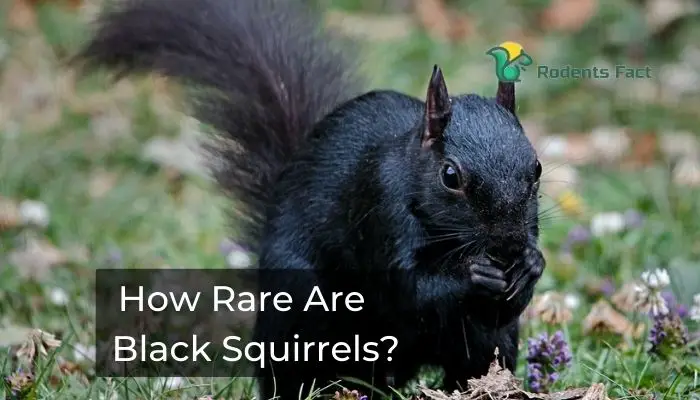How Rare Are Black Squirrels? | Know Where They Found
Are you curious about how rare are black squirrels? The black squirrel’s uniqueness has prompted many people to respect them, and they are utilized as emblems in several regions.
Individual black squirrels are an uncommon combination of both the eastern grayish and fox squirrels that may dwell anywhere gray or fox squirrels do.

Although black squirrels are uncommon, you will be astonished to learn that they are not as strange as they appear. The black fur coloration can develop spontaneously as a mutation in gray squirrel populations, although it is uncommon.
Reason for This Rare Color
Crossbreeding involving gray and fox squirrels, who possess a defective pigment gene known to give certain individuals of the typically reddish-brown species darker fur, is determined to be the cause of squirrels with black coats.
This gene variation, which is handed down from foxes to gray squirrels through mating, is just the same mutation that causes black squirrels to turn black.
Black squirrels in nature:
Where Do Black Squirrels Live?
Long before the advent of Europeans in the 16th and 17th centuries, when America’s old-growth woods were still numerous and dense, the black subgroup appears to have been dominant throughout North America.

The dark tint of the black squirrel helped it blend in with the deep and shady old-growth woodlands. Over time, increased deforestation and squirrel hunting for meat and pelts resulted in biological benefits for gray-colored animals.
Their light-gray hue became favorable in their newly altered habitat. The black subgroup of the eastern gray squirrel is now particularly common in the northern section of its range.
There are two basic reasons behind this. To begin with, black squirrels seem to have a much better cold tolerance than gray squirrels.
Moreover, since northern woodlands are thicker and hence dimmer, the black squirrel has a higher chance of hiding in this dimly light environment.
Black (eastern gray) squirrels may be found in large quantities across Ontario, as well as sections of Ohio, Maryland, Michigan, Houston, Texas, Indiana, Virginia, Washington, D.C., Iowa, Minnesota, Wisconsin, and Pennsylvania.
On the other hand, black squirrels are uncommon, accounting for only one in every 10,000 of the seemingly ubiquitous rodents.
The creatures may now be found in both their native North America and the United Kingdom, with locations as diverse as Ontario, Washington, D.C., and Ohio.
🐿️ Additional read: Chipmunks vs. Ground Squirrels!
Are Black Squirrels Aggressive?
At first, everyone assumed that almost all squirrels exhibited the same demeanor. So they were all spastic, eccentric, and food-driven. However, after conducting a significant study, we discovered some fresh facts.

Black squirrels, which are endemic to the Midwest, Quebec, Ontario, and areas of the Northeastern United States and the United Kingdom, are far more violent than grey and red squirrels.
These differences in attitude can be attributed to the squirrels’ increased levels of testosterone. The squirrels become “faster, fitter, ferociously territorial, and more aggressive” as a result of their higher-than-normal activity level.
This implies that black squirrels frequently outcompete grey squirrels for nutrition and mating, which is paradoxical given that black squirrels are a variety of grey squirrels.
Are Black Squirrels Dangerous?
There are a few signs that black squirrels vary from grey squirrels in ways other than color. Also, there are concerns regarding whether black squirrels also are more dangerous than grey squirrels.
Grey squirrels with a mutated gene that leads them to develop black fur are known as black squirrels. They are also more violent and aggressive than grey squirrels, and as a result, black squirrels will often drive all other squirrels out of a territory.
Experts may investigate if the defective gene, which is also prevalent in white blood cells, causes the black squirrel more dangerous, as it does in other mammals, according to one report on the black squirrel.
But another research looked at the aggressive behaviors of black and grey squirrels in an urban setting and found no differences.
Black Squirrel With Red Tail
The presence of red-colored black squirrels in a neighborhood in the southeastern United States has a simple interpretation. In black squirrels, many genes influence fur color, and a specific combination has resulted in squirrels with crimson tails, sides, or even the entire body.

Such alterations might happen at any time throughout multiple generations. A few years ago, the hue might not have been likely to be present.
In comparison to grey squirrels, black squirrels had a larger proportion of heat loss and a lower basal metabolic rate, according to studies. Pure white squirrels can be seen in tiny numbers in isolated groups in various places.
More reports of totally reddish-brown Gray Squirrels also with the grey and black mixed in have recently surfaced. Most of these squirrels have grey or black cores with reddish-brown tails or heads and ears, rather than reddish-brown.
Final Thoughts
“How rare are black squirrels” mention the scarcity of it. However, though the black squirrels are uncommon, they are found in many regions.
Squirrels, regardless of shade, are charming and entertaining to watch from a distance. A black squirrel is a sign of adaptation and transformation. These uncommon and adorable animals deserve all the love and attention they can get.
By the way, naturally, black squirrels are more aggresive than common squirrels. So, when you deal with them, just be careful, and keep a safe distance.




